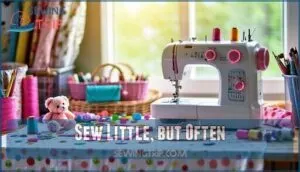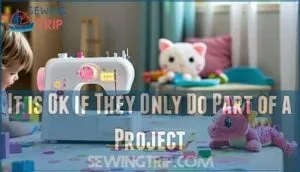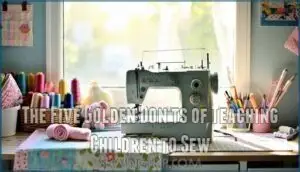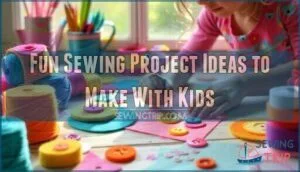This site is supported by our readers. We may earn a commission, at no cost to you, if you purchase through links.
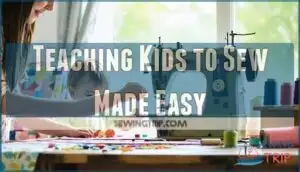
It’s great that you’re taking the time to pass this on, as it can create lifelong memories and usefulness.
You’ll find that teaching kids to sew is easier when you let them use real tools and work on projects they enjoy.
By keeping it simple and fun, you’ll help them develop a love for sewing that can last a lifetime, and who knows, you might just inspire a future fashion designer – so, what’s the first project you’ll tackle together?
Table Of Contents
- Key Takeaways
- Let Them Use Real Tools and Good Quality Tools
- It is Never Too Early to Teach Kids to Sew
- Sew Little, but Often
- It is Ok if They Only Do Part of a Project
- Once They Get a Taste for It – Let Them Sew!
- The Five Golden Don’ts of Teaching Children to Sew
- Get Kids Excited About Sewing
- Let Kids Make The Decisions
- Fun Sewing Project Ideas to Make With Kids
- Age and Safety Considerations
- Frequently Asked Questions (FAQs)
- Conclusion
Key Takeaways
- You’ll make teaching kids to sew easier by letting them use real tools and work on projects they enjoy, which helps them develop a love for sewing that can last a lifetime.
- It’s never too early to start teaching kids to sew, and with patience, they can develop an early skill, so don’t limit their potential by saying they’re too young to sew.
- You should avoid insisting on perfection, doing the sewing for your kids, continually suggesting how they should make their project, telling your child they’re too young to sew, and teaching if you feel inadequate, as these can hinder their learning and creativity.
- You can get kids excited about sewing by creating a fun environment, showing them the final project, and ending sessions with a treat, which will help them stay motivated and build their confidence in sewing.
Let Them Use Real Tools and Good Quality Tools
When teaching kids to sew, give them the right tools for the job.
Empower young creators with real tools—they’ll craft with pride and build skills that truly last.
Invest in sharp scissors, quality machines, and proper needles.
This will help them create something they can be proud of.
A child-friendly sewing kit with safe handling tools is a great place to start.
Remember, it’s worth the investment – sharp scissors and quality machines will make the learning process easier and more enjoyable.
As you teach kids to sew, emphasize safe handling and the importance of using the right tools.
A great starting point may be a complete sewing kit.
With the right tools and a little guidance, they’ll be sewing like pros in no time, and you’ll be amazed at what they can create with a quality sewing machine and some patience.
It is Never Too Early to Teach Kids to Sew
As you introduce your little ones to sewing, you’ll be amazed at how quickly they pick it up. It’s never too early to start, and with patience, they can develop an early skill.
Here are a few ways to get them started:
- Hand sewing simple projects
- Using large stitches on felt
- Creating fun sewing curves.
This creative exploration can lead to a lifelong hobby, building cognitive benefits and patience. A great way to begin is by encouraging their interests with personal project selection.
By starting early, you’re giving them a head start on developing a valuable skill. So, why not give sewing for kids a try and watch them thrive with beginner sewing kids projects and sewing lessons kids will love?
Sew Little, but Often
When sewing with kids, keep sessions short.
Try these:
- Quick stitches
- Fun themes
- Group activities
Frequent practice builds skills over time. Make it fun, not perfect. Celebrate their creations, and they’ll want more.
Short sessions with consistent learning help kids master sewing for kids projects, making beginner sewing kids and easy sewing kids a breeze with frequent practice and skill repetition.
Many resources provide simple pattern designs for beginners.
It is Ok if They Only Do Part of a Project
Sometimes life is messy—so are sewing projects for kids.
Embracing messy projects helps kids learn and have fun
If your child only finishes part of their masterpiece, that’s okay!
Partial Completion is part of the journey when teaching kids to sew.
Focus Matters more than a perfect finish, so let them enjoy the process.
Every stitch, even on a half-done pillow or an apron with just one strap, counts.
Celebrate Effort, big or small.
Adapt Projects to fit their rhythms and moods—Flexible Goals keep sewing fun and low-pressure.
Kids naturally want to pause, explore, or circle back later.
Support their curiosity and cheer those “almost there” moments.
Mastery takes time, so let their pride grow one seam at a time.
Learning sticks better than perfection.
Starting with appropriate sewing supplies can greatly aid in their success.
Once They Get a Taste for It – Let Them Sew!
As you witness your kids’ skill progression, let them take the reins on simple projects, fostering project independence.
- Let them pick fabrics and colors they love
- Guide them in using the sewing machine
- Collaborate on complex projects, handling tricky parts together
This creative exploration builds confidence, encouraging kids to try new sewing projects for kids. With your support, they’ll join a sewing community, sharing beginner sewing projects and teaching kids to sew with ease, developing essential sewing skills for children.
The Five Golden Don’ts of Teaching Children to Sew
You’re about to discover the secrets to teaching kids to sew without the frustration.
By following the five golden don’ts, you’ll create a fun and supportive learning environment that lets your kids thrive and enjoy sewing.
Avoid Insisting on Perfection
As you guide your child, remember to embrace imperfection.
| Learning Curve | Creative Freedom | Process Focus |
|---|---|---|
| High | Limited | Rigid |
| Medium | Growing | Flexible |
| Low | Full | Adaptive |
Celebrate effort, not perfection, to build sewing confidence and encouragement, avoiding common mistakes.
Avoid Doing The Sewing for Your Kids
When teaching kids to sew, let them take the reins.
Foster independence by not doing the sewing for them.
This encourages problem-solving, builds confidence, and promotes creativity, while developing patience, an essential sewing skill, through hands-on project encouragement.
Avoid Continually Suggesting How They Should Make Their Project
With creative freedom, let them make their own vision. It’s okay if it’s not how you’d do it! Offer gentle guidance, not control. Motivate with praise. Let them learn from mistakes.
Don’t continually suggest how they should make their project. Kids gain confidence with independent choices and their own solutions. Embrace imperfection on their sewing journey. Affirm their self-discovery!
- Let them pick the fabric.
- Praise their effort, not perfection.
- Remember, it’s about fun!
Avoid Telling Your Child They’re Too Young to Sew
Don’t limit your child’s potential by saying they’re too young to sew.
Some kids are ready earlier than you think.
Let them learn at their own pace with child-friendly sewing projects.
Early sewing benefits include confidence building and skill development.
Focus on interest-led learning and developmental readiness, allowing them to thrive in sewing skills and enjoy kids sewing projects.
Starting with age-appropriate tools can make the learning process safer and more enjoyable.
Avoid Teaching if You Feel Inadequate
Don’t let self-doubt impact your teaching.
Consider:
- Seeking resources
- Confidence building
- Alternative options
You can find supportive workshops for sewing skills, making it a fun experience for teaching kids to sew, and building your skillset limitations with child-friendly sewing and sewing safety in mind.
Get Kids Excited About Sewing
You’re about to help kids discover the joy of sewing, and it’s easier than you think.
By creating a fun environment, showing them the final project, and ending sessions with a treat, you’ll get them excited about sewing in no time.
Create a Fun Environment
You’ll make sewing a blast by playing upbeat tunes and using goofy fabrics.
- Create simple sewing games
- Host creative workshops
- Issue fun sewing challenges
- Reward progress with stickers
Make it a positive reinforcement experience, giving kids creative freedom to try playful projects and celebrate mistakes, all while having fun with sewing activities and projects.
Show The Final Project
You’re creating a fun environment, now show kids the final project.
Display their sewing projects for kids, celebrate completion, and share creations, making them proud, which motivates them to continue with kids sewing projects and ideas from a sewing kit or tutorial.
Many beginners start with easy fabric flowers, which is a great way to introduce them to sewing.
End The Sewing Session With a Treat
You end sewing sessions with a treat, like sewing snacks, to boost reward motivation.
Consider these:
- Cookies
- Fruit
- Cheese
- Cake, celebrating effort and sewing project satisfaction, creating positive sewing memories with family.
Let Kids Make The Decisions
You’re guiding kids to sew with ease, giving them project ownership which boosts creativity.
| Freedom | Outcome |
|---|---|
| Fabric Choices | Excitement |
| Pattern Selection | Pride |
| Design Input | Confidence |
| Creative Freedom | Joy |
| Project Ownership | Satisfaction |
This approach helps kids learn to sew with enthusiasm, exploring kids sewing ideas and sewing activities, focusing on sewing projects for beginners kids, and allowing design input and fabric choices.
Fun Sewing Project Ideas to Make With Kids
Imagination is the thread that weaves magic into sewing activities kids truly love. Beginner project selection is easy when you start with felt food, fabric memory games, rag dolls, or kid “boo-boo” bags.
Each project lets you upcycle fabric scraps and is perfect for fun sewing kids can finish with pride. Here are four favorites to spark enthusiasm:
- Sew a goofy felt sandwich for snack-time laughs.
- Craft a colorful fabric memory game—watch those little fingers work!
- Create rag dolls for storytelling or gifting.
- Stitch “boo-boo” bags—happy faces make ouchies easier.
Let kids customize with wild patterns or silly buttons. These activities help foster fine motor skills development.
Celebrate their creations; confidence grows with every stitch! Simple sewing kids choose builds skills and lifelong memories.
Age and Safety Considerations
How do you know when your child’s ready to learn to sew? Simple—follow their curiosity and match their age and skills with the right tools.
For the youngest crafters, think plastic needles and burlap—safe, sturdy, and perfect for child-friendly sewing. Stick close and keep supervision levels high, especially with sharp scissors and pins.
Once your kiddo hits 7 or 8, let them try simple hand-sewn toys and decorations. By 9 or 10, basic machine projects like doll blankets can be great, but use sewing machine safety features and always guide them.
Teach tool safety: no running with scissors, and keep everything tidy. Have a basic first aid kit handy—just in case. To guarantee safety, start with simple hand sewing to reduce injury risks.
Safe sewing builds confidence, not chaos!
Frequently Asked Questions (FAQs)
What is a good age to teach a child to sew?
You can teach a child to sew as young as 5, but 7-10 years old is often the easiest age to start, as they can follow instructions and use tools safely.
What is the first thing a beginner should sew?
You’ll start with simple projects, like a bookmark or tote bag, to build confidence and sewing skills, making it fun and easy to get started.
What age can a child start using a sewing machine?
You can introduce a child to a sewing machine around 7-10 years old, depending on their interest and fine motor skills development, with close adult supervision.
What are the basic skills for sewing for kids?
You’ll learn basic skills like threading, knotting, and straight-line sewing, which build confidence and fine motor skills, making sewing a fun and creative activity for kids.
What fabrics are best for beginners?
You’ll find felt, cotton, and chenille are great fabrics for beginners, offering ease of use and forgiveness for small mistakes, making the sewing process enjoyable and stress-free.
How to handle common sewing mistakes?
You’ll fix mistakes by ripping out stitches, rethreading, or using fabric glue, and don’t worry, it’s all part of the sewing process, even for experienced sewers, it happens.
Can kids sew without adult supervision?
You shouldn’t let kids sew without adult supervision, as they may accidentally hurt themselves with sharp objects or machines, so it’s best to guide them closely.
What skills are required for sewing?
You’ll need hand-eye coordination, fine motor skills, and patience to sew, as 64% of sewers report improved dexterity, so get ready to stitch your way to new skills.
How to store sewing supplies safely?
You store sewing supplies safely by keeping them organized, out of reach of children, and in a dry place, using containers or bags to prevent damage and loss.
Conclusion
Now you’re sewing seeds of creativity, literally, by teaching kids to sew.
You’ll watch them grow, and it’s amazing.
Don’t worry if it gets messy, it’s all part of teaching kids to sew.
With patience, they’ll learn, and who knows, you might just raise a future designer, so keep it fun and let them sew.

